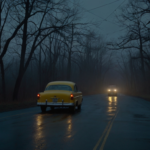
Maple Heights Residential Complex was once a beacon of community living—a place where families thrived, children played freely, and evenings were filled with the aroma of chai and laughter. But everything changed one fateful winter evening when Neha and Anjali, two inseparable college friends, disappeared without a trace.
The girls were last seen leaving the complex to attend a study session at a nearby library. They never arrived. Their frantic parents searched every corner of the city, filed missing persons reports, and pleaded on television for their safe return. Weeks turned into months, and the world moved on. But Maple Heights did not.
The residents were left with an unshakable unease—a sense that something sinister lingered in their midst.
Months after the girls vanished, the complex began to change in ways that defied logic. It started subtly:
At first, there were soft whispers at night, as if someone was calling out faintly from the hallways.Then came the sounds of barefoot footsteps, echoing on floors that should have been empty.The lights in the stairwells began to flicker, plunging parts of the building into unsettling darkness.
One night, Mrs. D’Souza, who lived on the fifth floor, woke up to the sound of someone sobbing outside her bedroom window. Trembling, she peeked out and saw a figure in white, standing motionless on the roof of the opposite building. Its face was obscured by long, tangled hair. Before Mrs. D’Souza could scream, the figure vanished into thin air.
She was found unconscious the next morning, clutching her rosary.
The complex’s security guard, Ram Prasad, was the first to meet a gruesome fate. Known for his bravery and sharp instincts, Ram took it upon himself to investigate the growing complaints of strange noises near the basement.
One stormy night, armed with nothing but a flashlight, he descended into the dimly lit corridor leading to the storage rooms. His flashlight flickered erratically, casting distorted shadows on the walls.
As he reached the end of the hallway, he noticed a door slightly ajar. A foul stench wafted out, making him gag. “Who’s there?” he called out, his voice echoing in the stillness.
Suddenly, the door slammed shut, and Ram’s flashlight went out. What happened next was heard, not seen—his blood-curdling screams tore through the night. By the time help arrived, Ram’s body was found sprawled in the basement, his face twisted in sheer terror. Deep claw-like marks ran across his chest, and his eyes were wide open, staring at something unseen.
After Ram’s death, fear gripped Maple Heights. Residents began locking their doors before sunset, and children were no longer allowed to play outside. The whispers grew louder, and sightings of shadowy figures became more frequent. The complex’s WhatsApp group buzzed with theories—some believed it was the girls’ spirits seeking revenge; others whispered about dark rituals.
One name kept cropping up in hushed tones: Manish.
Manish was a reclusive man in his late 30s who lived alone on the ground floor. He was rarely seen during the day and had an unsettling habit of lingering near the basement at odd hours. When questioned, he claimed he was working on “a project.” His vague answers and cold demeanor made him the subject of many rumors.
The truth came to light in the most horrifying way imaginable.
One evening, a group of teenagers dared each other to explore the infamous basement. Armed with their phones and flashlights, they ventured into the dark corridors, laughing nervously to mask their fear. They found nothing at first—just old furniture, broken appliances, and dusty storage boxes.
But as they reached the farthest corner, they heard a faint sound—a low, guttural growl. Their laughter stopped abruptly.
“Let’s get out of here,” one of them whispered. But before they could move, the growl grew louder, followed by the sound of footsteps—heavy, uneven footsteps.
Panic set in. The group turned to flee, but standing in the doorway was a ghastly figure, its skin pale and decomposed, its eyes glowing faintly in the dark. It was wearing what appeared to be a college uniform.
One of the boys screamed, “It’s her! It’s Neha!”
The figure lunged at them with unnatural speed, and chaos erupted. The teens scattered, but one of them, Aarav, tripped and fell. As the others ran, they heard his agonized screams echo through the basement.
When the police arrived, they found Aarav’s lifeless body near the basement stairs, his throat slit and his face frozen in terror.
The police conducted a thorough search of the basement and stumbled upon a hidden door behind a stack of old furniture. It led to a secret room filled with items that sent chills down their spines:
Black candles arranged in a circle. A journal filled with cryptic symbols and detailed accounts of “experiments.” And at the center of the room, a large industrial refrigerator, locked with heavy chains.
Breaking it open revealed the bodies of Neha and Anjali, perfectly preserved in a grotesque chemical solution. Their eyes were open, their mouths slightly ajar, as if frozen mid-scream.
Manish was arrested the same night. Under intense interrogation, he confessed to the unimaginable. He had lured the girls to his flat under the pretext of helping them with an assignment. Once inside, he drugged and killed them.
But his depravity didn’t end there. Obsessed with the idea of controlling life and death, Manish had studied ancient occult practices and experimented with reanimating the dead. Using chemicals and rituals, he had managed to temporarily bring the girls back to life as mindless, obedient zombies.
“They were perfect,” he said with a chilling smile. “They did whatever I wanted. But they were incomplete… I was still working on making them whole.”
Even after Manish was taken into custody, the horrors at Maple Heights didn’t stop. Residents began reporting more terrifying incidents:
Bloodstains appeared on the walls of the stairwells, only to vanish the next morning. People heard scratching sounds at their doors at night, accompanied by faint whispers begging for help. Several residents claimed to see two figures standing in the courtyard at midnight, staring up at the building with empty eyes.
One night, a young girl named Riya woke up screaming. She told her parents she saw two women standing at the foot of her bed, their faces pale and decayed.
The complex’s priest was called in to perform a cleansing ritual. He spent hours in the basement, chanting prayers and sprinkling holy water. When he emerged, his face was pale.
“These girls are not at peace,” he said. “Their souls are trapped between worlds, bound by the dark rituals performed here. Until they are freed, this place will remain cursed.”
The priest instructed the residents to burn the bodies and conduct a mass prayer. Reluctantly, the families gathered in the courtyard, lighting a massive pyre. As the flames consumed the remains, a chilling wail echoed through the air, sending shivers down everyone’s spine.
Months later, life at Maple Heights seemed to return to normal. The whispers ceased, the shadows disappeared, and the residents began to rebuild their sense of safety.
But on certain nights, when the moon was high and the wind howled through the corridors, some claimed to hear faint laughter and footsteps echoing from the basement.
And in the faint glow of the courtyard lights, two shadowy figures could sometimes be seen standing side by side, watching silently.
The legacy of Maple Heights was forever etched in the minds of its residents—a haunting reminder of the darkness that can lurk behind closed doors.


















































